
The 12th season of Top Chef – a French TV show about the art of cooking – kicked off on channel M6 on February 10 and will run for 18 weeks. It is recorded at Studio 210 a bigger studio located in La Plaine Saint Denis in order to comply with the current safety guidelines regarding Covid 19.
Vincent Faure-Chappat, the director of photography, had to adapt his lighting kit, with the help of Impact Événement one of the three vendors involved with the show – who provided most of the lighting rig.

Although television production has been authorized to continue, it is on the condition that precise sanitary regulations are respected to avoid spreading the virus. The size of Studio 210 is part of this effort, and ensures minimum social distancing on the set, which can host up to 28 people: 14 production technicians and 14 cooks, the number of whom decreases with each elimination.
In order to satisfy the needs of the director, the studio is separated into three distinct production areas. The large set where the candidates cook and which also hosts the tasting table for the coaching chefs, six interview rooms with green screen backdrops, and the “Green Room” where the tastings are viewed by the candidates and the chefs.
There are so many areas to be lighted, to be enlivened and even more, since the big stage includes four different zones of interest: the kitchen with the work surfaces spaced out in the center, the tasting table, the wall of ovens and the pantry.
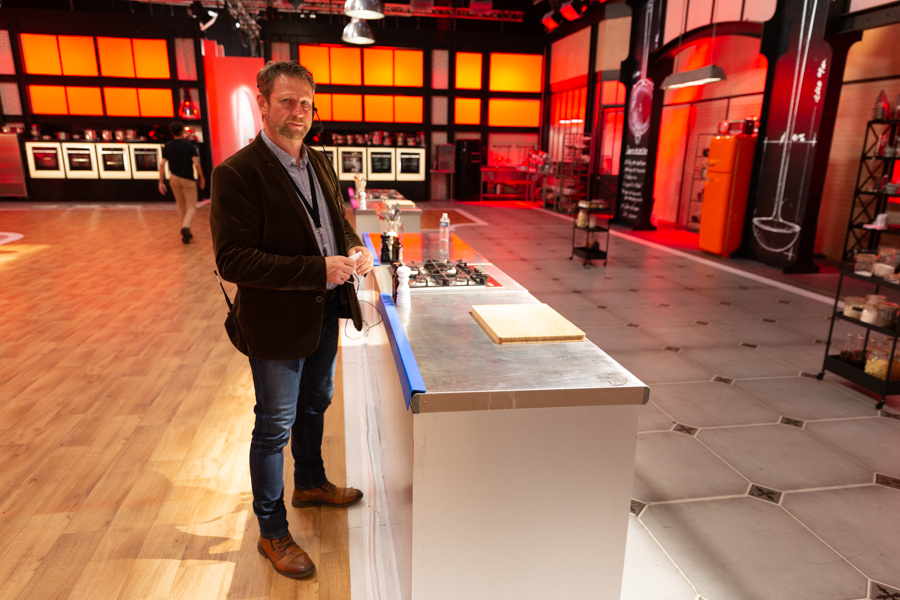
Are you hungry to learn the secrets of this cult culinary program?
Then just keep reading! Vincent Faure-Chappat, Director of Photography for Top Chef, generously shares his lighting recipes.
SLU : Vincent, how did you come to be part of Top Chef?
Vincent Faure-Chappat : Sebastien Zibi, the director, asked me to handle the interview rooms on season 5 because he never had the time to manage them. These are small sets where the interviews with the candidates take place one after the other. There were four of them then.
Then Sébastien Zibi asked me if I wanted to take over for season 6. I agreed, on the condition that I could redesign the lighting, otherwise it would be just as well to keep the previous director of photography. I took two months to re-watch seasons 4 and 5 in their entirety to analyze the lighting and I noticed that the shadows of the moving cameramen were very noticeable. My primary job was to remove these shadows that were wandering around on the work surfaces.

SLU : How many cameras are on the set?
Vincent Faure-Chappat : Up to eight fixed cameras, plus one on a crane, one on a “Monkey” and the cameras of the “journalist” teams that capture the evolution of the events more closely.
SLU : Is the production involved in the selection of the equipment, and how did you get to know Impact Evénement?
Vincent Faure-Chappat : The production is not involved in the choice of materials, but in determining the budget. After all, I’m a bit different because I’ve had a company for 17 years (Chapimages Productions) and I work with different rental companies or vendors who can provide me with the technical resources to achieve the results I have in mind. We started working with Impact on Top Chef a year ago, but I have known Stéphane Fleury for 25 years. Ultimately, it’s a business of exchange and learning.

Before Top Chef, we did season 3 of “Le Meilleur Pâtissier Professionnel” together another cooking show based on pastry.
The production wanted an atmosphere with moving lights. Together with Impact, we found the solutions. This allowed me to move to a new Ayrton package for Top Chef last year, which we are now updating.
This year, because of Covid and the need to ensure social distancing, the set has been enlarged. It was therefore necessary to significantly increase the lighting resources. Now I’m not going to talk about the budget because that doesn’t concern me anymore, but the goal is to guarantee the results.
SLU : What are the challenges on a show like Top Chef?
Vincent Faure-Chappat : The show is constantly evolving. The producers regularly invent new events, or change them from one day to the next. So we also have to be very reactive with the lighting and anticipate as much as possible. Sometimes we literally have 30 seconds to adjust.
For example, if the production organizes an event with ice cream, we have to be ready to shoot the dishes as soon as they arrive, and the same goes for soufflés, before they fall. The cooks are sometimes a little stressed because they want their dish to look as good as possible on camera, which is normal. So we’re on the ball for them too.
SLU : What were your considerations in choosing the lighting package needed for season 12?
Vincent Faure-Chappat : This is my seventh year designing the lighting for Top Chef, and every year there are changes in the sets and changes in the technical resources according to the requests for new events from the producers.
For me, the director of photography has to be the mediator between the director and the technical department and must adhere to the needs of the director. Today, for example, there is a lot more movement on the show that justifies the use of moving lights. The fixtures are also evolving rapidly with LED solutions that generate inspiration and creativity and that considerably reduce power consumption.
Again this year, I increased the number of moving lights to replace a lot of profiles. The rig is in fact a combination of fixed soft LEDs, LED movers and a few more conventional fixtures. As for the moving lights, I use 30 Ghibli profiles, 14 Diablo profiles, 5 Levante washes and 26 NandoBeam S6 washes, all of which are LED sources from Ayrton.
For the LED soft lights, I have 20 Arri SkyPanels, 10 DMG SL1 Maxi Switches and 8 Cineo TruColor HS lights. I am gradually replacing the conventional lights because they consume a lot of energy and heat up the set. The participants used to sweat a lot in front of the ovens. In comparison, last year, they almost got cold (laughs)!
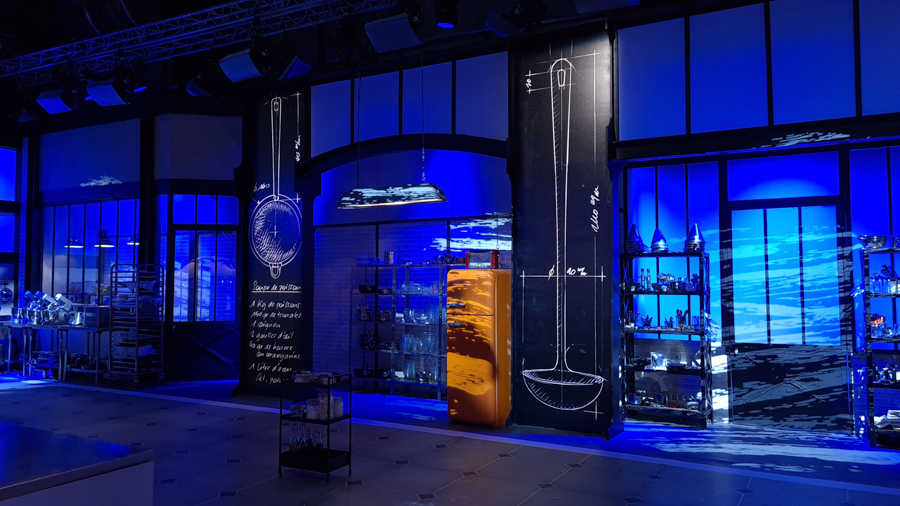
SLU : How much did you manage to lower the temperature?
Vincent Faure-Chappat : By 15 degrees. In the kitchen, that’s noticeable because the ovens and stovetops are working. In season 4, the temperature on the set even went beyond what could be considered acceptable. The chefs and candidates were sweating constantly, so I worked hard to remedy that by working with LEDs.
On season 5, in the 10 m² interview rooms, there was a 400 HMI Joker and four 800 W Redheads, the temperature was close to 40 degrees.
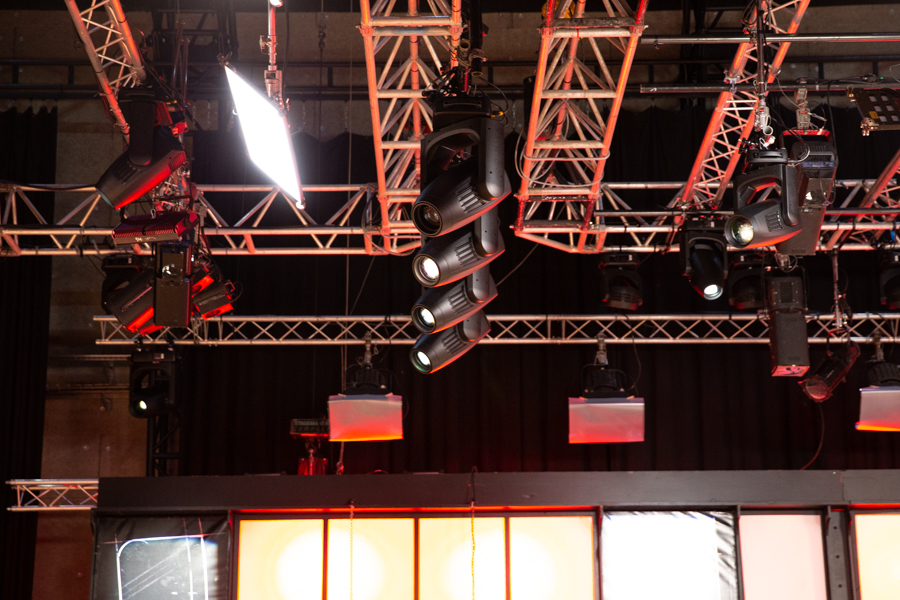
SLU : Apart from the lower power consumption and less radiated heat, do LED lights have any other advantages in TV?
Vincent Faure-Chappat : The LED has a high CRI that remains consistent over the years. The Ghibli, which I use, for example, as key lighting for the coaches, has a filter on the color wheel that raises the CRI to 92. You don’t get magenta or green dominance on Philippe Etchebest’s or Hélène Darroze’s skin, as with the ETC 750 profiles with either plus- or minus-green gels.
SLU : Does every coach get a specific treatment?
Vincent Faure-Chappat : Everyone’s skin responds differently. Some absorb light and others reflect it. So I play with the intensities. For example: Hélène Darroze needs less light and has a slightly pinkish dominant that I correct with the Ghibli. On the contrary, I push the intensity on Philippe Etchebest and Paul Pairet, who are almost the same, needing about 300 lux more than Hélène.
Michel Sarran, on the other hand, has a tendency to absorb light with a grayish-green tone, which forces me to add 200 to 300 lux more than for Paul and Philippe and to make the necessary corrections to the CRI. Having four chefs side by side and well balanced at the tasting
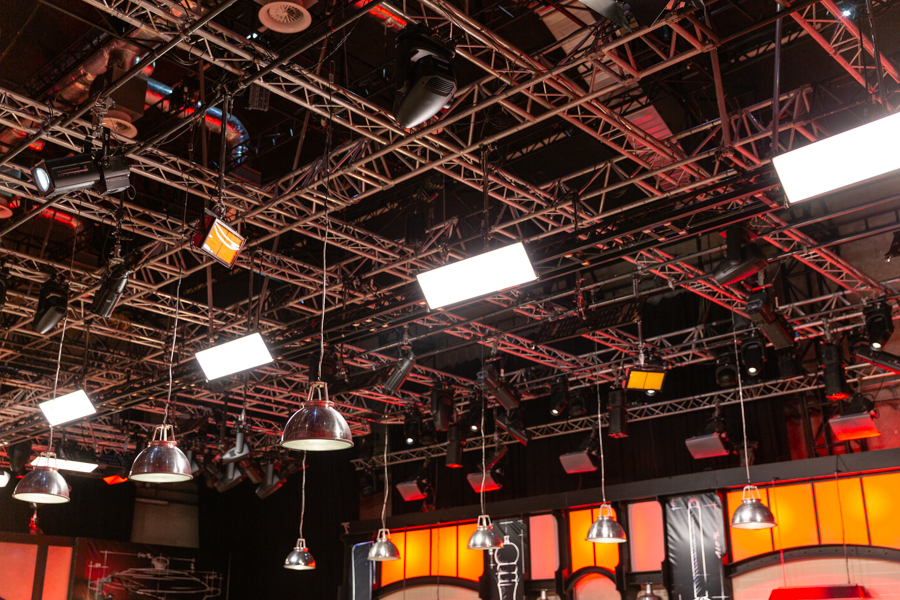
SLU : Could you give us a more detailed breakdown of the lighting on the set?
Vincent Faure-Chappat : The ten SL1 Maxi Switches, which were developed about five years ago by the French company DMG, provide key lighting for the contestants when they are in front of their work surface. They are softly lit and free from the shadows of the camera operators. It is a big, 120 cm panel that consumes 250 watts.
The Maxi Switch is unique in that it is essentially two panels that are hinged and can be folded and operated separately with a broad spread of diffused light. All the backlighting for the cooks is still done with 2 kW Fresnels corrected at ⅛ CTB + ¼ frost. I push them a little extra to create an iridescent effect.
I also have some Cineo Trucolor HS lights, which are phosphor plates that have the same function as the SL1, providing key lighting during the events. They are also part of the soft fills, so that the shadow of the approaching cameraman is very limited and soft. I really like these phosphor panels, which have a very nice and soft light and are a step ahead of the SkyPanel.
The disadvantage is that the panels don’t generate colors, you have to choose their color temperature between 3200 K, 4300 K or 5600 K and they wear out quickly. They were therefore somewhat forgotten and replaced by more versatile projectors that allow color and the choice of color temperature via DMX.

Next, all the frontal lighting of the host, Stéphane Rotenberg, the jury, but also the candidates when they come around the table of the chefs, is done using the Ayrton Ghiblis for the quality of their light with their CRI filter, and for the flexibility of movement that they bring.
Back when I used to use 52 tungsten profiles for this purpose, we had to anticipate the position of each of them the day before the shoot and correct their light with gels, because we never had perfectly identical lamps. Today, 20 Ghiblis are enough to cover all the angles.
Some Oxo ColorZoom 180 LED fixtures are used exclusively for the decor to make “curls” of color on the bricks. I also added SkyPanels that let us play with the colors behind the canvas backdrops installed above the ovens and refrigerators. In previous years, 500 W quartz fixtures and 1250 W cyc lights were used for this purpose.
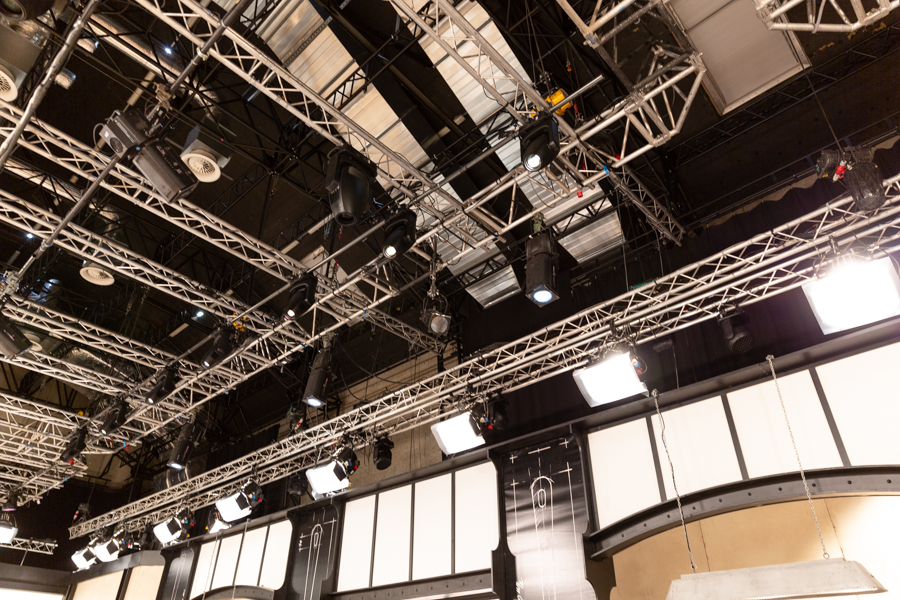
The Ayrton Diablo TCs are also a new addition, with their profiling module that allows us to frame the countertops. They are basically little Ghiblis and I use them to do all the back lighting for the contestants.
What’s new is that we also use them to create beams and effects such as the scene change for the final elimination round, when Stéphane Rotenberg gives the signal to start the event.
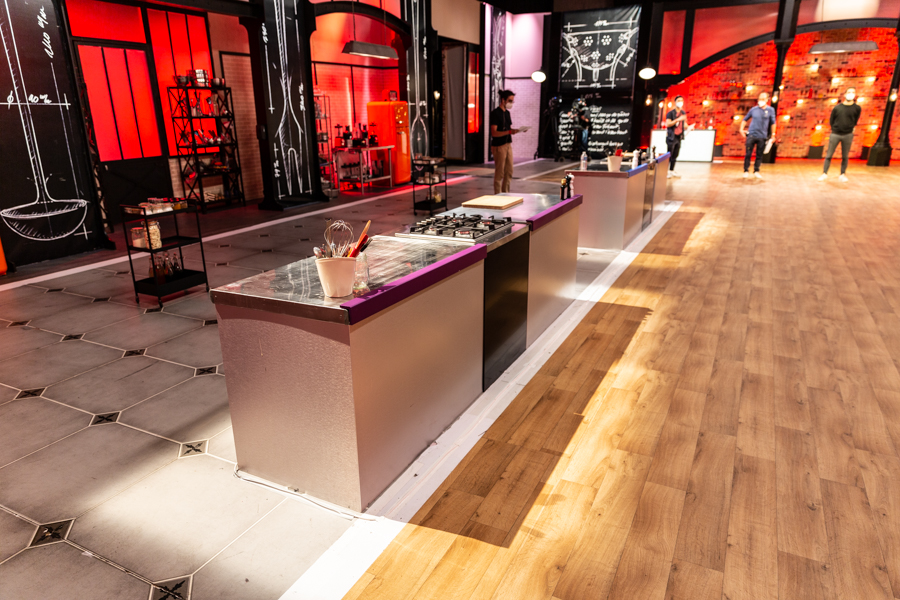
We then go into a dark and saturated red ambiance with rectangular red backgrounds. On the last season, the moving heads we used didn’t have framing shutters like the Diablo TC, so the contestants had a circle at their backs. This resulted in a round shadow within the scene. This year, I wanted to use straight lines to keep the concept a bit cubic. These are just little details that the director of photography wants to use, and if you’re going to have framing lights, you might as well use them.

I have some NandoBeam 6 LED washes that allow me to create the colors on the walls and on the refrigerators, some Robert Juliat 714SX profiles to light the columns and project “window-pane” gobos on the floor, and finally the classic 500 watt Quartz that create the “curls” on the bricks.
SLU : Do you use smoke or haze machines for the effects?
Vincent Faure-Chappat : We use a DF-50 for the portrait shots of the contestants, shot with a Sony FS7 camera in a slightly dark atmosphere with beams behind them. We also use haze to highlight the beams during the beauty shot. It also works for close-ups of hands, fires or simmering pots and pans, which creates an atmosphere for the editing.
They are turned on before the events and I create a light that is a little more elaborate with flare effects. These are little things that, when the production is not pressured by time, allow me to improve the image.
SLU : How do you work with the scenography?
Vincent Faure-Chappat : Under some glass containers, I added some Yegrin Quadra 10×16 cm stand-alone miniatures, in order to create points of light that the director can use to bring a little more depth to the scene, especially during the tasting.

I like the idea of bringing a little contrast and volume to the set. What is very complicated in television is making everyone look good while having a nice, overall atmosphere from several camera angles.

SLU : Please tell us how you handle the ITW rooms.
Vincent Faure-Chappat : This is the first year that the ITWs will be shot against a green screen (lit with LedGo bars). Until last year we used printed backdrops. To avoid reflections, we printed on satin canvases, but this resulted in a kind of grey halo, a sort of veil.
We lost contrast and were forced to make corrections in the curves of the cameras in order to recover deep blacks and to light them with a minimum of intensity… It was torture!
Today, chroma-keying allows us to maintain the purity of the blacks and a recorded background with a 4K CMOS image, which is subtly blurred in order to create a certain depth of field.
On the other hand, the chefs and the contestants are lit (with Fiilex PPRs) in correspondence with the background photo. This gives the pseudo-impression that the interviewees are in a natural setting. The integration alleviates many problems of brightness and quality and, above all, consistency of the backgrounds in the six interview rooms.
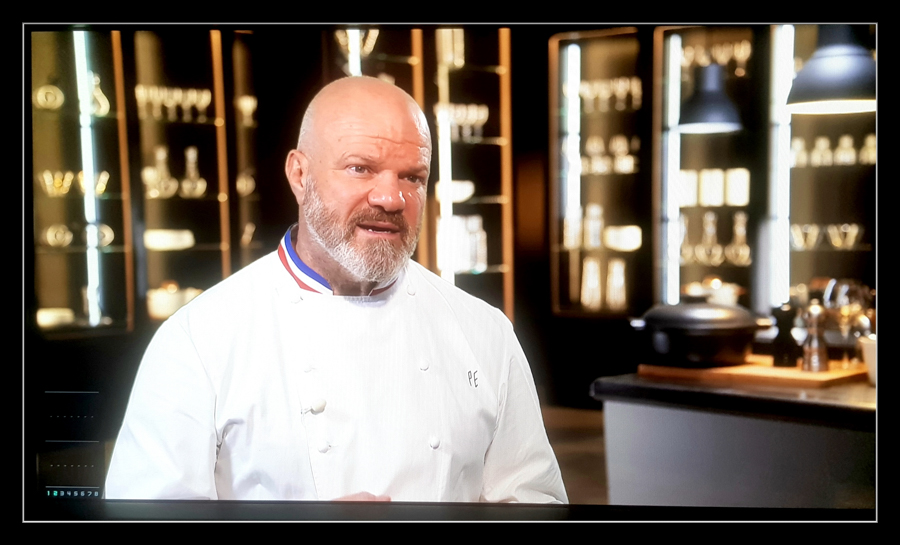

SLU : Do you use CAD software to design your lighting plots?
Vincent Faure-Chappat : I’ve been using Vectorworks for the past five years to produce accurate simulations for the production department and, above all, because I’ve been asked to work on shows that are more and more technical and where I need to save time on installation by preparing the designs in advance. It is a vital tool.
I took the set designed by Valérie Litz in .dwg format and the file of the Studio 210 stage that Thierry Roche of AMP provided to me in order to insert the set into the room. I was then able to position the fixtures virtually, and very precisely, to construct the lighting.
SLU : Do you work with the main set as a single unit?
Vincent Faure-Chappat : I have defined zones that are functionally meaningful: The pantry area, the oven area, the kitchen area and the chefs’ area, and I separate the tungsten lights from the LEDs… which allows the console operator to distinguish the sources. The more you identify the fixtures by their technological type, the more you compartmentalize them, the more efficiently you can communicate.
The file that includes all the designs is shared with the technicians. It’s a way to remove doubts for the crew and to avoid problems of misalignment of the fixtures, so that they don’t have to be re-focused.
SLU : What career path has brought you to this profession?
Vincent Faure-Chappat : When I obtained my CAP in photography in 1986, I continued my studies in video because my goal was to become a cameraman. After that and after several internships, I succeeded, after many attempts, to join the very closed circle of the Cinema Des Armées (ECPA – ed. note) in 1989 as a military cameraman for two and a half years.
In this institution, I got to travel and move around. It was a fabulous experience. After the army, during the heyday of Canal+ and Delarue’s talk shows (1990 to 1996), there was a frenzy of shooting for TV, feature films, theater and concerts. During my many assignments, I was able to meet and discuss with directors of photography from cinema and TV. This aroused my interest in exploring a complementary profession to the camera: lighting…
SLU : In other words, with your knowledge, you gradually took over the light as well as the camera?
Vincent Faure-Chappat : Yes, at the beginning, you start with three Redheads and when you ask for a 2 kW Blonde, they systematically tell you that it’s too expensive. So you manage with gelatins to try to create an atmosphere, which the other guys don’t do.
During my 26 years of journalism and documentary work, I realized that when I was filming I always had a lighting stand in the way when I was moving around, so I kept wondering where I could hide the stand or my light, etc. This is what got me my start on “Queer”. It was the adaptation of an American show broadcast on TF1 and featuring five gay men giving makeovers to staunchly straight men.
I ended up lighting with conventional equipment purchased at Leroy Merlin or Bricorama and it was bulbs and fluorescent tubes that I hid behind the furniture to obtain a radiance across the walls and create an atmosphere. There were obviously catastrophic colorimetric consequences that we would smooth out with gelatins, minus-green, plus-green, 1/4ths and 1/8ths to obtain a more or less uniform spectrum overall. Personally, I have never done lighting, I just do images – that is to say, a camera shot of the light. And the two have to match, otherwise it doesn’t work.

SLU : I assume you have a very dedicated team.
Vincent Faure-Chappat : For the past 16 years with Chapimages Productions, I have trusted the same people because the human aspect is very important to me and I find that in television it is something that has been lost significantly. It is important that my teams be able to tell me things. I regularly work with four chief electricians who have different skills.

The console operators, Elliott Ganga and Remy Nicollet, are virtuosos in their field, along with the chief electricians Sylvain Divat and Nicolas Lefievre, they are fundamental on Top Chef. They are also very much in demand by other directors of photography.
I also benefit from their knowledge and their contact with the lighting vendors, as well as from their objective opinion on the equipment. What is very important for me is to try to work with what the rental companies have in their inventory to avoid subcontracting. This creates a certain respect in our partnership so we can reduce costs.
SLU : One last very important question: do you taste the dishes at the end of the shoot?
Vincent Faure-Chappat : No, there is only one person who really tastes all the dishes besides the chefs and that is Stéphane Rotenberg (laughs). There’s not enough to go around, anyway, and with the Covid restrictions it’s forbidden to share.

Impact Événement, a pioneer of LEDs for television
Since 1987 Impact Événement has been known for its expertise as a service company for conventions and trade shows and, since 1994, in the broadcasting industry.
A branch was even specially created in La Plaine Saint-Denis in 1998 to support TV and film shoots. This branch is managed by Philippe Journet and Fabrice Morcel.
It is their relationship with Vincent Faure-Chappat that has allowed for the development of the lighting kit for the show.
We appealed to the memory of Stéphane Fleury, Associate Director at Impact, to take us back in time.


SLU : How long have you been using LEDs for television productions?
Stéphane Fleury : The first set to be equipped with LED fixtures was that of Hit Machine in 2003. It was done at the time using the Easycolor, the first Ayrton LED fixture, with the help of Alain Duc, the show’s director of photography. We were very quickly convinced that it was the future! You could make incredible tints and lower the power consumption enormously. Then, Thierry Rollin, the director of photography for “Combien ça Coûte”, produced by Christophe Dechavanne, chose us.
It was the first set of a TV show in France, and maybe even in Europe, that was 80% lit by LED fixtures. So now we have more than 20 years of experience with LED lighting, an analysis of its relationship to the image and the camera, and a range of moving lights that have very accurate color temperature, colorimetry and adjustable CRI.


Conclusion
– Providing comprehensive lighting on a set being recorded by 10 calibrated cameras.
– Creating perspective and depth on the set.
– Inventing a visual structure for the show and shifting from the white ambiance of a kitchen to the saturated and red environment, increasing the sense of anxiety for the final round, or dark blue for the eliminations.
– Controlling the shadows of the eight moving cameramen.
– Carefully choosing and balancing the light sources to avoid the dazzling effect of the LEDs causing overexposure (a result too often observed today on TV shows).
– Knowing how to light the chefs to make them “attractive”, but without blinding them either.
– Making sure that the image transmitted over the airwaves or by fiber arrives beautifully at your home, regardless of your television and its settings, so that you can focus on the content…
This is the wide range of tasks that Vincent Faure-Chappat undertakes with meticulousness, vast experience, immense talent and a large dose of creativity.
Top Chef season 12 lighting team
Grand MA console operators: Elliott Ganga and Remy Nicollet
Chief electricians: Sylvain Divat and Nicolas Lefievre
Electricians: Christain Comas and Alain Thernisien
More information is available on the Chapimage website and on the Impact Événement website









